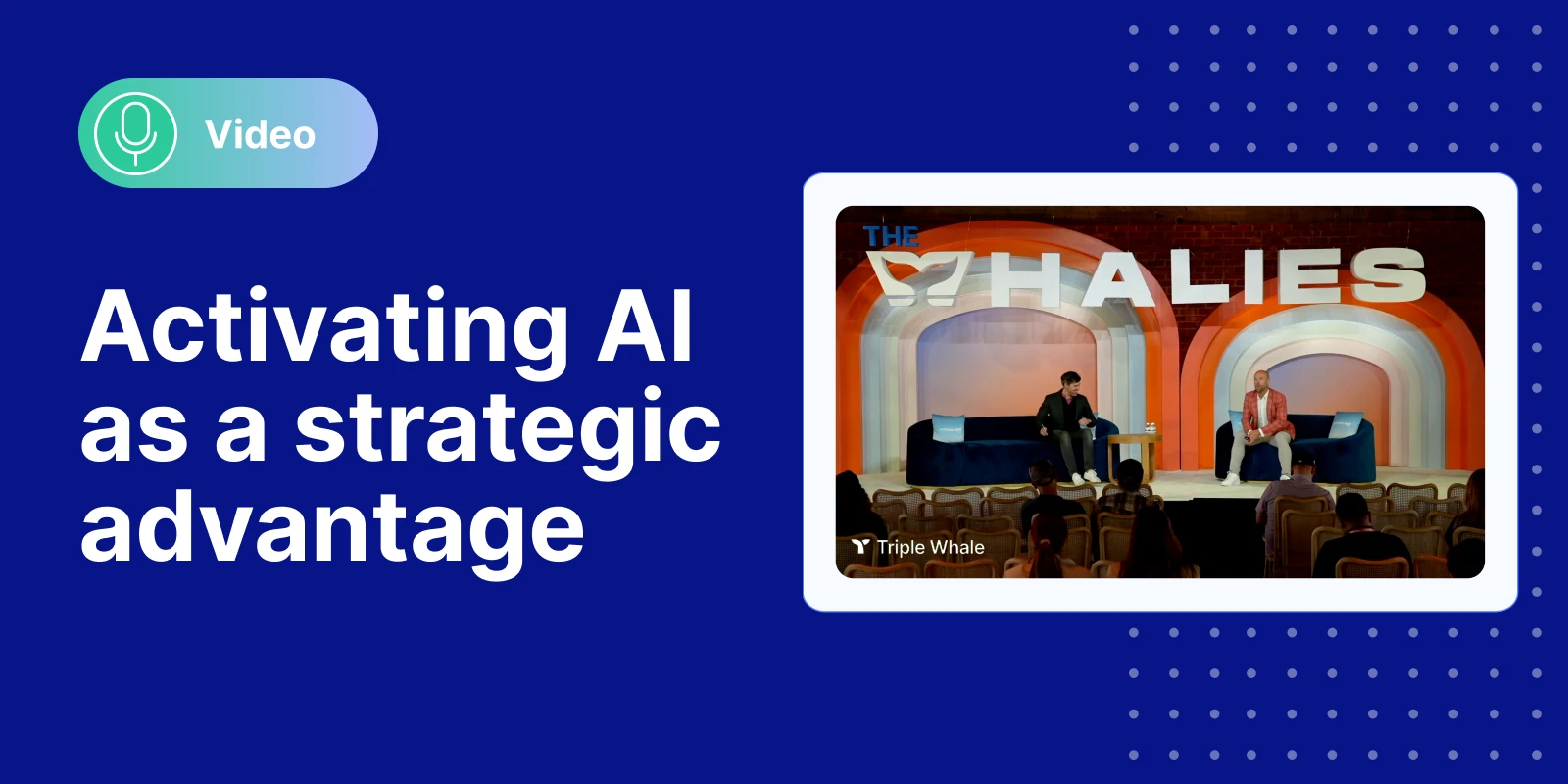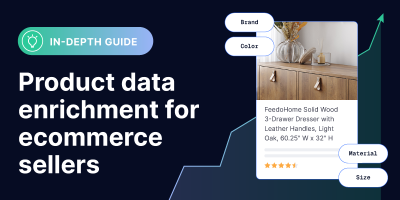At this year’s Whalies, hosted by Triple Whale, the brightest minds in ecommerce gathered to explore strategy, data-driven growth, and cutting-edge tech. As part of the programming, Feedonomics and Google took the stage to present a session titled, “Activating AI as a Strategic Advantage.”
The conversation featured Colin Madden, VP of Sales at Feedonomics, and Greg McKallagat, Senior Commerce Manager at Google. Their session went beyond the “what” of AI tools, to examine the “how” and “why” behind real AI success in ecommerce businesses.
Their core message? Artificial intelligence isn’t magic—it’s a multiplier. And its effectiveness is entirely dependent on your product data, your infrastructure, and your feedback loops.
Below are six key insights from their talk, with actionable recommendations to help ecommerce teams turn data and AI into a true strategic edge.
Don’t forget to check out the full presentation as well!
1. AI shopping has the power to replace traditional search, and product data must keep up
Today’s consumers—especially younger ones—are increasingly skipping Google and retailer websites. Instead, they use conversational AI-powered platforms like Gemini, ChatGPT, or Perplexity to search and shop. This shift demands a fundamental change in how brands think about their product data, especially as AI technology becomes more embedded in customer experiences and online shopping behavior.
Madden emphasized how a product title that works well on a website—like “Olive Arcadia 2025”—can fail in an AI-driven search context. On your own site, a shopper already browsing handbags might appreciate a stylized name. But on Google Shopping or Gemini, where discovery starts from scratch, it’s ineffective.
“When that 25-year-old now who’s literally only using Gemini to do their product searches—they’re maybe not looking for an olive bag,” Madden said. “Maybe they’re just looking for a handbag. And maybe they know it’s green, but are they searching for olive?”
Madden’s point: A product title or attribute that performs well on one platform may fail on another unless it’s translated into the language of the customer and the function of the channel.
Retailers need a way to normalize their data for listings beyond their own site: stylized, brand-preferred terms should be mapped into universal language that matches search behavior, like “olive” to “green.”
AI tools rely on normalized, literal product data to match results to user intent, improving relevance with more personalized product recommendations. If your feed isn’t clear and descriptive, you’ll miss the opportunity to appear in relevant results and improve conversion rates.
How to gain a strategic advantage
- Audit your product titles and attributes for clarity and alignment with how customers speak.
- Create structured, feed-optimized data with attributes like color, material, use case, and category.
- Ensure your feed reaches AI-reliant tools via Google Shopping, Merchant Center, and other data pathways.
2. Generic feeds are getting outpaced by channel-specific content
Not all channels are created equal. What works on your ecommerce site might not resonate on TikTok, Amazon, or Meta. Madden explained how many brands still make the mistake of using the same product content everywhere.
“If you’re sending the same data to your website as you are to Google, as you are to TikTok, as you are to Amazon, you’re probably doing it wrong… That is literally what we call a dumb pipe,” Madden said.
Instead, today’s ecommerce leaders are creating channel-specific feeds that reflect each platform’s nuances—whether that means more descriptive titles for search, lifestyle imagery for social, or normalized attributes for marketplaces.
How to gain a strategic advantage
- Customize your product data per platform (e.g., short titles for social media ads, rich ones for marketplaces).
- Build automation rules that adapt metadata dynamically per destination.
- Tap into partnerships to centralize and orchestrate this complexity, don’t try to build everything in house.
3. Performance feedback loops drive smarter product strategy
The smartest brands aren’t just optimizing listings—they’re turning real-time performance data into strategic fuel. Madden shared a vivid example: a major volleyball brand wasn’t converting well until it realized the word “beach” was a top keyword driving sales, and most listings didn’t contain “beach.”
“You need to be feeding that performance data back… so that you’re adjusting spend, which channels you’re listing on, and even which products you’re selling,” Madden said.
Rather than treat your product feed as a static output, think of it as a dynamic learning system, updated with feedback from analytics platforms.
How to gain a strategic advantage
- Use analytics platforms like Triple Whale, in addition to Google Analytics, to identify top-converting terms and product variants.
- Integrate attribution data into your PIM or feed manager to adapt listings based on actual performance.
- Treat content iteration (titles, product descriptions, attributes, imagery) as a core growth lever, not a one-time task.
Feedonomics prepares your data so you can execute smarter strategies.
4. Personalized visual content will be generated in real time for each user
One of the most forward-looking parts of the session was McKallagat’s take on AI-generated visual personalization. It’s no longer about using the same lifestyle image across the board. It’s about adapting your creative based on the viewer, demographics, and purchase history for more personalized shopping experiences.
He shows an example of a lifestyle image being personalized to its customer.
“What you’re looking at here is a woman holding this bag,” McKallagat said. “What if we knew… it’s actually a man doing the search and we automatically in real time change it to a man in the lifestyle image holding the bag?”
McKallagat painted a future where generative AI tools adapt visuals based on age, gender, style, and context in real time. That’s the next wave of conversion optimization—driven by machine learning and user behavior.
How to gain a strategic advantage
- Use AI tools (e.g. Adobe Firefly, Midjourney) to create lifestyle variations from base product images.
- Enrich your customer segmentation data to feed intelligent creative systems.
- Begin piloting generative video tools for dynamic ads across YouTube, TikTok, and Meta.
5. Data signals must be precise — AI can’t work without clean inputs
Despite all the talk about AI, nothing works if your underlying signals are broken. McKallagat drove this home by pointing to the often-neglected importance of pixel and tag hygiene.
“We need to make sure that these pixels and these tags are updated as quickly as possible… data fidelity and tag fidelity is now actually the most important thing going forward to be able to leverage AI and these AI agents,” he said.
Whether it’s a pixel, Google Ads Tag, or Triple Whale conversion API, each of these signals is part of your AI strategy. Ignore them, and your optimization engines go blind.
How to gain a strategic advantage
- Maintain a schedule for checking and updating tracking pixels across ecommerce platforms.
- Collaborate across dev and marketing teams to ensure operational efficiency, signal accuracy, and resilience.
- Treat data completeness as a core component of your brand’s digital infrastructure.
6. Strategic data governance is the new human role in AI commerce
AI can analyze, predict, and even create—but it can’t interpret mistakes. That’s where human strategy still matters. McKallagat shared how marketers must evolve into data stewards, not just content creators.
“What it’s not going to be able to do is necessarily diagnose, ‘Hey, if it’s giving you wrong information, why?’… and that’s where humans are going to have to step in and be the data managers,” McKallagat said.
The companies that win won’t be the ones with the most AI tools—but the ones with the clearest data ownership, oversight, and alignment across systems.
How to gain a strategic advantage
- Train internal teams on data flows, tagging systems, and feed health—not just campaign tools.
- Establish clear ownership for diagnosing data issues between platforms (Triple Whale vs. Google Ads, etc.).
- Hire, upskill, or partner with team members who can serve as AI strategists and feed managers, not just operators.
Conclusion: AI isn’t enabling the strategy, data is
At The Whalies, Feedonomics and Google offered a practical framework for using AI in ecommerce. Success with AI doesn’t come from simply adopting new tools; it depends on having structured, high-quality data that those tools can actually use.
That means:
- Clean product data, structured for machines
- Customization for each channel’s nuance
- Performance feedback loops that sharpen strategy
- Strong internal ownership over signal quality and data interpretation
As Madden noted, “Your job isn’t going to be taken by AI. It’s going to be taken by someone who knows how to use AI.”
In broader terms, the businesses that succeed aren’t just using AI, they’re supplying it with the right inputs to get better outputs.
That means investing in the right infrastructure, understanding how your data flows between systems, and treating your product feed as a key driver of performance across channels.
How Feedonomics enables AI-ready ecommerce strategies
As AI tools become more integrated into product discovery, advertising, and personalization, the quality and adaptability of your product data are more important than ever. This is where Feedonomics plays a critical role.
Feedonomics helps businesses centralize, optimize, and distribute their product data across hundreds of channels—including Google Shopping, Meta, Amazon, TikTok, and emerging AI-driven platforms. What sets the platform apart is its ability to:
- Normalize and enrich product data to meet platform-specific requirements
- Automate feed optimization using flexible rule logic and AI-assisted enhancements
- Integrate performance data to continuously improve listings through feedback loops and streamline product optimization workflows
- Support channel-specific content that aligns with both marketing strategy and customer behavior
In short, Feedonomics provides the infrastructure to transform raw product information into high-performing, AI-compatible feeds—so that no matter where shoppers are searching, browsing, or buying, your products are discoverable, relevant, and ready to convert.
Let’s turn your data into a strategic advantage.
Creating an AI-ready ecommerce strategy FAQs
How are AI tools being used in the ecommerce industry?
AI is transforming nearly every aspect of ecommerce operations—from logistics and product data to marketing, customer service, and fraud detection. With applications ranging from inventory forecasting to creative automation, AI gives businesses the tools to streamline workflows, personalize customer experiences, and make smarter, faster decisions across their entire operation.
Ecommerce businesses leverage AI algorithms and machine learning to analyze historical data and real-time signals, enabling more accurate demand forecasting, intelligent inventory management decisions, and refined pricing strategies.
AI is also accelerating content creation, allowing businesses to generate images, marketing copy, and other creative assets faster and more effectively across multiple channels.
These AI-driven capabilities empower ecommerce businesses to operate more efficiently, adapt with precision, and lead confidently in a rapidly evolving digital marketplace.
How are consumers interacting with AI when shopping online?
Today’s consumers engage with AI across multiple touchpoints in the shopping journey. From visual search to conversational queries powered by natural language processing (NLP), AI helps users find products faster and more intuitively. Shoppers also interact with chatbots and virtual assistants on ecommerce sites and social platforms, receiving instant answers, style suggestions, and help with checkout.
These experiences are enhanced by AI’s ability to interpret customer preferences, past purchases, and behavior to deliver personalized recommendations. As these tools become more advanced, they improve the user experience, guiding product discovery and building customer loyalty through meaningful, responsive engagement.
Where do feed management platforms fit into an AI-ready ecommerce strategy?
Feed management platforms are essential for powering AI systems with clean, structured product data. By normalizing product titles, descriptions, and attributes across different channels, these platforms ensure that AI models have the inputs needed for relevant search matches, ad targeting, and personalized recommendations.
Additionally, feed management platforms enrich and structure product data so it can be accurately interpreted by AI systems like Google Shopping, ChatGPT, and Perplexity. By normalizing attributes, filling in missing details, and optimizing product listings for each channel’s requirements, these platforms ensure your data remains discoverable, dynamic, and aligned with how AI platforms surface and recommend products.
Feed management platforms like Feedonomics also enable real-time synchronization of inventory, pricing, and availability, enabling you to handle dynamic pricing and inventory to support AI-use cases like agentic checkout, which rely on up-to-date product information.
In a world where the power of AI shapes discovery and shopping decisions, feed management platforms serve as the connective tissue between your online store and the intelligent systems driving the future of ecommerce.

Mario is a senior content marketing manager based in Texas. He enjoys solving problems, learning about new ecommerce tech, and breaking down complex topics into useful tips for readers.


